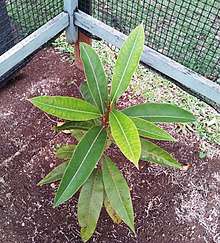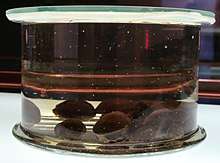Sideroxylon grandiflorum
Sideroxylon grandiflorum, known as tambalacoque or dodo tree, is a long-lived tree in the family Sapotaceae, endemic to Mauritius. It is valued for its timber. The Sideroxylon grandiflorum fruit is analogous to the peach. They are both termed drupes because both have a hard endocarp, or pit, surrounding the seed, with the endocarp naturally splitting along a fracture line during germination.
| Sideroxylon grandiflorum | |
|---|---|
 | |
| Young tree | |
| Scientific classification | |
| Kingdom: | Plantae |
| Clade: | Tracheophytes |
| Clade: | Angiosperms |
| Clade: | Eudicots |
| Clade: | Asterids |
| Order: | Ericales |
| Family: | Sapotaceae |
| Genus: | Sideroxylon |
| Species: | S. grandiflorum |
| Binomial name | |
| Sideroxylon grandiflorum A.DC. | |
| Synonyms[1] | |
| |
History

In 1973, it was thought that this species was dying out. There were supposedly only 13 specimens left, all estimated to be about 300 years old. The true age could not be determined because tambalacoque has no growth rings. Stanley Temple hypothesized that the dodo, which became extinct in the 17th century, ate tambalacoque fruits, and only by passing through the digestive tract of the dodo could the seeds germinate. Temple (1977) force-fed seventeen tambalacoque fruits to wild turkeys. Seven of the fruits were crushed by the bird's gizzard. The remaining ten were either regurgitated or passed with the bird's feces. Temple planted the remaining ten fruits and three germinated. Temple did not try to germinate any seeds from control fruits not fed to turkeys so the effect of feeding fruits to turkeys was unclear. Reports made on tambalacoque seed germination by Hill (1941) and King (1946) found the seeds germinated without abrading.
Temple's hypothesis that the tree required the dodo has been contested. Others have suggested the decline of the tree was exaggerated, or that other extinct animals may also have been distributing the seeds, such as tortoises, fruit bats or the broad-billed parrot. Wendy Strahm and Anthony Cheke, two experts in Mascarene ecology, claim that while a rare tree, it has germinated since the demise of the dodo and numbers a few hundred, not 13. The difference in numbers is because young trees are not distinct in appearance and may easily be confused with similar species. The decline of the tree may possibly be due to introduction of domestic pigs and crab-eating macaques and competition with introduced plants. Catling (2001) in a summary cites Owadally and Temple (1979), and Witmer (1991). Hershey (2004) reviewed the flaws in Temple's dodo-tambalacoque hypothesis.
In 2004, Botanical Society of America's Plant Science Bulletin disputed Dr. Temple's research as flawed which published evidence as to why the dodo's extinction did not directly cause the increasing disappearance of young trees including suggestion that tortoises would have been more likely to disperse the seeds than dodo hence discrediting Temple's view as to the dodo and the tree's sole survival relationship.[2]
Uses
This dodo tree is highly valued for its wood in Mauritius, which has led some foresters to scrape the pits by hand to make them sprout and grow.[3]
See also
- Sideroxylon majus, a species native to Réunion, that has been confounded with Sideroxylon grandiflorum (particularly under its synonym Calvaria major)
References
- "The Plant List".
- Herhey, David R (2004). "The Widespread Misconception that the Tambalacoque or Calvaria Tree Absolutely Required the Dodo Bird for its Seeds to Germinate". Plant Science Bulletin. 50 (4). ISSN 0032-0919.
- Ellis, Richard (2004). No Turning Back: The Life and Death of Animal Species. New York: Harper Perennial. pp. 164. ISBN 0-06-055804-0.
External links
- Catling, P. M. (2001): Extinction and the importance of history and dependence in conservation. Biodiversity 2(3): 2-13 pdf
- Helfferich, C. (1990): The Turkey and the Tambalacoque Tree
- Hershey, D. R. (2004): The widespread misconception that the tambalacoque absolutely required the dodo for its seeds to germinate. Plant Science Bulletin 50: 105–108.
- Hill, A. W. (1941): The genus Calvaria, with an account of the stony endocarp and germination of the seed, and description of the new species. Annals of Botany 5(4): 587–606. PDF fulltext (requires user account)
- King, H. C. (1946): Interim Report on Indigenous Species in Mauritius. Port Louis, Mauritius: Government Printer.
- Owadally, A. W. & Temple, Stanley A. (1979): The dodo and the tambalacoque tree. Science 203(4387): 1363–1364.
- Quammen, David (1996): The Song of the Dodo: Island Biogeography in an Age of Extinction. Touchstone, New York. ISBN 0-684-82712-3
- Temple, Stanley A. (1977): Plant-animal mutualism: coevolution with Dodo leads to near extinction of plant. Science 197(4306): 885–886. HTML abstract
- Witmer, M. C. & Cheke, A. S. (1991): The dodo and the tambalacoque tree: an obligate mutualism reconsidered. Oikos 61(1): 133–137. HTML abstract